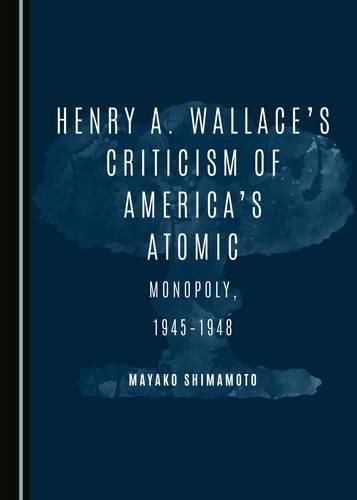Readings Newsletter
Become a Readings Member to make your shopping experience even easier.
Sign in or sign up for free!
You’re not far away from qualifying for FREE standard shipping within Australia
You’ve qualified for FREE standard shipping within Australia
The cart is loading…






Secretary of Commerce Henry A. Wallace was an earnest supporter of the Stimson Proposal, a disarmament proposal submitted to the Truman administration by then Secretary of War Henry L. Stimson immediately after World War II. This proposal suggested direct dialogue with the Soviets over control of the newly-released atomic energy used against Japan in August 1945.Wallace, who had nurtured a deep scientific knowledge in his early life, was trusted in his Vice Presidency (1941-1945) for his scientific skills by not only President Franklin D. Roosevelt, but also scientific administrator Vannevar Bush. Because of this, Wallace’s postwar vision was similar to Stimson’s Proposal and the views of atomic scientists, who believed that basic scientific knowledge could not be contained because science had no national boundaries. Why was Wallace so thoroughly neglected by incumbent President Harry S. Truman and his fellow policy-makers? Wallace’s idea, basically encouraging a joint partnership with the Soviets, failed to find favor with Truman, his aides, and the American public. Their belief was that the US’s secret of atomic bomb was a national asset.This book illustrates that Wallace’s idea of international atomic controls with Soviet partnership - a position embraced by atomic scientists - could prevent a postwar nuclear proliferation. The failure of Wallace’s concept of postwar world order, a product of rejection by President Truman, has revealed an ideological conflict between democracy and nuclear weaponry. Amazingly, Wallace daringly made this historic attempt and kept to his vision, a commitment which led to his alienation and eventual ousting from Truman’s cabinet.
$9.00 standard shipping within Australia
FREE standard shipping within Australia for orders over $100.00
Express & International shipping calculated at checkout
Secretary of Commerce Henry A. Wallace was an earnest supporter of the Stimson Proposal, a disarmament proposal submitted to the Truman administration by then Secretary of War Henry L. Stimson immediately after World War II. This proposal suggested direct dialogue with the Soviets over control of the newly-released atomic energy used against Japan in August 1945.Wallace, who had nurtured a deep scientific knowledge in his early life, was trusted in his Vice Presidency (1941-1945) for his scientific skills by not only President Franklin D. Roosevelt, but also scientific administrator Vannevar Bush. Because of this, Wallace’s postwar vision was similar to Stimson’s Proposal and the views of atomic scientists, who believed that basic scientific knowledge could not be contained because science had no national boundaries. Why was Wallace so thoroughly neglected by incumbent President Harry S. Truman and his fellow policy-makers? Wallace’s idea, basically encouraging a joint partnership with the Soviets, failed to find favor with Truman, his aides, and the American public. Their belief was that the US’s secret of atomic bomb was a national asset.This book illustrates that Wallace’s idea of international atomic controls with Soviet partnership - a position embraced by atomic scientists - could prevent a postwar nuclear proliferation. The failure of Wallace’s concept of postwar world order, a product of rejection by President Truman, has revealed an ideological conflict between democracy and nuclear weaponry. Amazingly, Wallace daringly made this historic attempt and kept to his vision, a commitment which led to his alienation and eventual ousting from Truman’s cabinet.